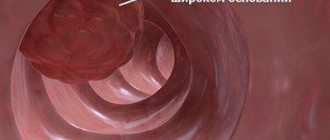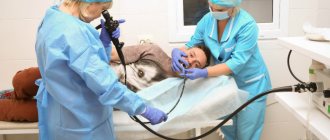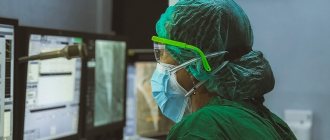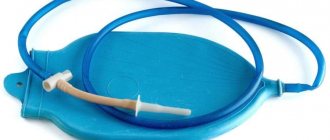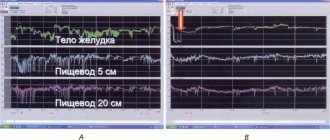Home » Department of Surgery » Procedures » Gastric resection
Gastric resection is a radical operation that is aimed at removing part of the pathologically altered stomach. The main indications for performing these interventions are: complications of gastric and duodenal ulcers (perforation, penetration, bleeding, pyloric stenosis), benign and malignant neoplasms.
Classification
Gastric resection is classified as follows:
- Depending on the location of the part of the organ to be removed Proximal resection (the cardiac part and part of the body of the stomach are removed)
- Distal resection (the antrum and part of the body of the stomach are removed)
- Depending on the shape of the part of the stomach to be removed Wedge-shaped
- Stepped
- Circular
- Tubular
- Segmental
- Depending on the volume of the part of the stomach to be removed Economical – resection of 1/3 – ½ of the stomach
- Extensive – resection of 2/3 of the stomach
- Subtotal – resection of 4/5 stomach
- Depending on the technique of execution Open (from the classical approach - upper median laparotomy, from the small access - mini-laparotomy using endosurgical instruments and techniques)
- Fully laparoscopic
- Laparoscopically assisted resection using assistive devices
- Depending on the method of restoring the integrity of the gastrointestinal tract Preserving gastroduodenal continuity (direct gastroduodenal anastomosis) - gastric resection according to Billroth 1
- With the replacement of the removed part of the stomach with a segment of the small intestine (jejunogastroplasty)
- Gastrojejunal anastomoses with unilateral exclusion of the duodenum (gastric resection according to Billroth 2
- Depending on the area of the stomach to be excised Pylorectomy
- Antrumectomy
- Cardectomy
- Fundectomy
- With and without preservation of the pyloric sphincter
- With and without the formation of an artificial valve in the area of the gastroduodenal or gastrojejunal anastomosis.
The most practical scheme for determining the levels of gastric resection is:
- 2/3 of the stomach is removed along a line running on the lesser curvature 2.5 - 3 cm distal to the esophagus, i.e. through the place where the first branch of the left gastric artery enters the stomach, and along the greater curvature through the junction of the right and left gastroepiploic arteries, which corresponds to the lower pole of the spleen.
- 3/4 of the stomach is resected along a line passing along the lesser curvature 1 - 1.5 cm distal to the esophagus and along the greater curvature - at the lower pole of the spleen with the intersection of two gastric branches of the left gastroepiploic artery.
- With subtotal resection, the line of intersection of the stomach goes along the lesser curvature at the edge of the esophagus, and along the greater curvature at the lower pole of the spleen with the intersection of one short gastric artery.
- Hemigastrectomy (removal of half the stomach) occurs along a line that connects the point lying on the lesser curvature 4 cm away from the esophagus, and on the greater curvature the point separating the left outer third of the gastrocolic ligament.
There are more than 50 modifications of gastric resection with gastroduodenal anastomosis, and more than 80 methods of gastric resection with gastrojejunal anastomosis. Most often, gastric resections are performed according to Billroth 1, Billroth 2, Billroth 2 modified according to Hofmeister - Finsterer, Haberer - Finney, Roux.
General definition
Billroth-1 and 2 techniques are types of gastric resection. This is a surgical operation used to treat serious diseases. These include pathologies of the stomach and duodenum. The technique involves removing part of the stomach. At the same time, the integrity of the digestive tract is restored. For this purpose, a gastrointestinal anastomosis is created. This is the connection of fabrics using a certain technology.
Billroth is a fairly serious operation. It was the first successful surgical intervention of this type. Nowadays the technique is being improved. There are other ways to successfully remove part of the stomach. However, Billroth is still actively used in world-famous clinics. Surgical operations performed using the presented method in Israel are especially known for their high quality.
It is worth noting that the method of resection largely depends on the location of the pathological process. The type of disease also influences this. Most often, Billroth-1 and 2 are prescribed for stomach ulcers or cancer. Before the operation, the size of the excised area is assessed. Next, a decision is made on the method of resection.
The Billroth technique is one of the most frequently used during gastric resection. There are a number of differences between these techniques. They appeared at different times. However, Billroth-1, although it is the first technique of its kind, is still quite effective today.
Stages of gastric resection
- Mobilization – intersection of the gastric vessels along the lesser and greater curvature between ligatures throughout the resection area
- Resection – removal of the area of the stomach planned for resection
- Restoring the continuity of the digestive tube - gastroduodenoanastomosis or gastroenteroanastomosis
Operation according to the Billroth method 1 - creation of an end-to-end anastomosis between the stump of the stomach and the stump of the duodenum.
Operation according to the Billroth method 2 – formation of a “side to side” anastomosis between the stump of the stomach and the loop of the jejunum.
Operation Billroth 2 in the Hofmeister-Finsterer modification - the essence of this modification is as follows:
- The stump of the stomach is connected to the jejunum using an end-to-side anastomosis.
- The width of the anastomosis is 1/3 of the lumen of the gastric stump
- The anastomosis is fixed in the “window” of the mesentery of the transverse colon
- The afferent loop of the jejunum is sutured with 2-3 interrupted sutures in the stump of the stomach to prevent the reflux of food masses into it.
The operation according to the Billroth method 1 has an important advantage compared to the Billroth method 2: it is physiological, since it does not disrupt the natural passage of food from the stomach and the duodenum is not excluded from digestion. The most important disadvantage of all modifications of the Billroth 2 operation is the exclusion of the duodenum from digestion.
Billroth-1: disadvantages
Operations according to Billroth 1 and 2 also have certain disadvantages. They must be taken into account when choosing a surgical procedure. During the Billroth-1 operation, duodenal ulcers may be observed.
With this method of surgical intervention, it is not possible to qualitatively mobilize the intestine in all cases. This is necessary to create an anastomosis without tension on the suture. This problem occurs especially often in the presence of duodenal ulcers that penetrate into the pancreas. Also, severe scarring and narrowing of the intestinal lumen can lead to the inability to properly mobilize the duodenum. The same problem occurs when ulcers develop in the proximal stomach.
Some surgeons enthusiastically insist on performing Billroth-1 resection, even if there are a number of unfavorable conditions for its implementation. This significantly increases the likelihood of suture failure. Therefore, in some cases it is necessary to abandon the Billroth-1 operation. If there are significant difficulties, it is better to give preference to surgical intervention using the second method.
It is extremely important that the technique of the surgeon who will perform the operation be carefully honed and practiced as much as possible. Although Billroth-1 is considered an easier, faster technique, it is performed exclusively according to strict indications. The decision to conduct it is made only if certain factors are present and certain obstacles are absent.
In some cases, this operation requires mobilizing not only the duodenum, but also the spleen and intestinal stump. In this case, it is possible to create a seam without tension. Extensive mobilization greatly complicates the operation. This unnecessarily increases the risk during its implementation.
It is also worth noting that resection using the Billroth-1 technique is not performed during the treatment of gastric cancer.
Complications of the “operated stomach”
- Dumping syndrome
- Afferent loop syndrome (reflux of food masses into the afferent loop of the small intestine)
- Peptic ulcers
- Gastric stump cancer
Often such patients have to be operated on again - to perform reconstructive surgery, which has 2 goals: removal of the pathological focus and inclusion of the duodenum in digestion.
Please note that all form fields are required. Otherwise we will not receive your information. Alternatively use
Sorry. This form no longer accepts new data.
Differences between methods
It should be noted that the techniques of Billroth 1 and 2 are significantly different. The connection point in the first case is called “ring into rings”. With Billroth-2, the anastomosis has a side-to-side appearance. Accordingly, due to such intervention, complications may develop in both cases. However, in both cases they are not similar.
It is worth noting that the degree of expression of dumping syndrome in Billroth-2 is more pronounced. The work of the stomach itself and the entire gastrointestinal tract after these operations is also different. With Billroth-1, the patency of the intestinal tract is preserved. However, this operation is not performed for stomach cancer, extensive ulcers and gross changes in stomach tissue. In these cases, the Billroth-2 technique is indicated.
Indications for Billroth-1 are the following conditions:
- Peptic ulcers of the stomach. This is the least controversial indication. In this case, resection of 50-70% of the stomach gives a good result. In this case, an addition in the form of a truncal vagotomy is not required. The only exception is surgery for prepyloric ulcers and pathologies in the area of the turn in the case of increased gastric secretion.
- For duodenal ulcers, resection of 50-70% of the stomach is indicated, but only when using truncal vagotomy.
Indications for Billroth-2 can be stomach ulcers, which have almost any localization. If half of the stomach is excised, truncal vagotomy is used.
Also, for stomach cancer, the only possible option for excision of the affected tissue is Billroth-2. This is explained by the ability to perform extensive resection not only of the stomach, but also of regional lymph nodes and the duodenum. In this case, the occurrence of anastomotic obstruction is less likely than in the case of the first technique.
Preparing for surgery
If surgery is performed as planned, additional studies are required.
A general blood test is a routine test to determine the general condition of the body, the absence of inflammatory diseases, the synthesis of formed elements, etc.
Extended blood test with platelet level determination - assessment of the patient's blood clotting ability.
Biochemical blood test - assessment of synthetic (PTI, PTV, total protein) and detoxification (ALT, AST, urea) liver function, filtration activity of the kidneys (urea), pancreas (blood glucose level).
A general urine test is used to determine the condition of the urinary system and the presence of infectious diseases.
The Wasserman reaction (RW) is a serological test for the presence of syphilitic infection.
Electrocardiogram - assessment of cardiac functions.
Chest X-ray - used to exclude tuberculosis, lung cancer, mediastinal tumors and other pathologies.
These studies are mandatory for any patient admitted to the hospital. Using the data obtained, the doctor can objectively judge the general condition of human organs.
Additionally (at the doctor's discretion), the following examination methods can be used:
- Fibroesophagogastroduodenoscopy (FEGDS) is an invasive method that involves inserting a long probe with a video camera into the esophagus, stomach, duodenum and objectively examining the condition of these organs.
- X-ray examination of the abdominal organs (including the use of contrast agents).
- Ultrasound examination is carried out for the purpose of differential diagnosis of various diseases, clarifying the diagnosis, location and size of tumors, etc.
The number and type of all additional studies are always individual for each patient, and depend on a number of factors (age, concomitant diseases, state of the cardiovascular, excretory, respiratory, endocrine, nervous systems, and so on).
